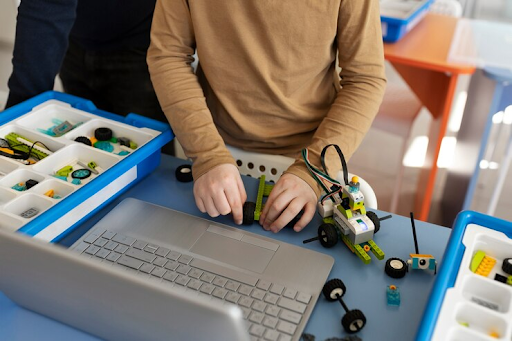Education shapes our society. It’s the backbone of progress and innovation. From ancient philosophers to modern-day thinkers, knowledge has always been a powerful tool. The evolution of education reflects changes in culture and technology. Today, it’s more accessible than ever, yet challenges remain. We explore its impact on personal growth and community development. Understanding education’s role helps us appreciate its value and potential. Dive into the journey of learning and discover how it influences every aspect of our lives.
Technology Transforms Learning
Innovative Tools
Educational technology has reshaped how educators teach. Innovative tools enhance traditional teaching methods. Tools like smartboards and interactive software make lessons more engaging. Students can participate actively, which improves retention.
Multimedia Resources
Integration of multimedia resources caters to diverse learning styles. Videos, podcasts, and simulations provide multiple ways to grasp concepts. Visual learners benefit from graphics, while auditory learners thrive on discussions. This diversity in resources enriches the learning experience.
Collaboration Through Technology
Technology fosters collaboration among students and teachers. Online platforms allow for real-time communication and group projects. Students can share ideas, leading to a sense of community. This collaborative environment encourages peer-to-peer learning.
Digital Literacy
Digital literacy is vital in today’s education landscape. It equips students with necessary skills for the workforce. Schools must prioritize digital literacy in their curricula. Training teachers in instructional technology is essential for effective integration.
Education Initiatives
Digital learning initiatives are being adopted globally. These initiatives aim to enhance educational outcomes through technology. Countries emphasize education innovation to prepare students for future challenges.
Online Platforms Revolutionize Education
MOOCs Access
Massive Open Online Courses (MOOCs) have changed the educational landscape. They provide access to quality education for anyone with an internet connection. Platforms like Coursera and edX host courses from top universities. This allows learners worldwide to study subjects that interest them.
Self-Paced Learning
Flexibility defines online learning environments. Students can learn at their own pace, fitting studies around their schedules. This structure accommodates different learning styles and commitments. It encourages individuals to take control of their education.
Networking Opportunities
Social media plays a vital role in modern education. Platforms like LinkedIn and Twitter facilitate networking among students and educators. Users can share resources, discuss topics, and collaborate on projects. These connections enhance the overall learning experience.
Digital Tools
Educational tools have evolved significantly with technology. Digital textbooks and interactive content engage students more effectively than traditional materials. Online platforms offer various resources that cater to diverse learning styles.
Digital Literacy Programs
Digital literacy programs are essential in today’s educational systems. They equip students with necessary skills for online learning. Understanding how to navigate educational platforms is crucial for success in this digital age.
Digital Tools Boost Engagement
Gamification
Gamification transforms traditional learning. It incorporates game-like elements into educational activities. This approach makes lessons more interactive and fun. Students become more motivated when they earn points or badges for completing tasks. Research shows that gamified learning can increase student engagement by up to 60%.
Multimedia Presentations
Multimedia presentations capture attention effectively. They combine text, images, audio, and video. This mix appeals to different learning styles. For instance, a history lesson can include videos of historical events alongside text. Such presentations help students retain information better. According to studies, students remember 65% of what they see and hear compared to just 10% of what they read.
Real-Time Feedback Tools
Real-time feedback tools enhance participation. These tools allow teachers to gauge understanding instantly. Platforms like Kahoot! let students answer questions during lessons. Immediate results show where students excel or struggle. This instant feedback loop encourages active involvement in the classroom.
Digital skills are essential in today’s education landscape. Schools must address the digital divide to ensure equal access to these tools. Embracing digital technologies prepares students for future careers. Engaging methods foster a love for learning and build critical thinking abilities.
Enhancing Accessibility with Tech
Mobile Content
Mobile-friendly content allows learners to access education anytime, anywhere. This flexibility supports students who may not have traditional access to educational environments. In 2021, mobile devices accounted for over 50% of global web traffic. Creating responsive designs ensures that all students can engage with educational materials effectively.
Assistive Technologies
Assistive technologies play a crucial role in supporting students with disabilities. Tools like screen readers and speech recognition software enhance educational access for these learners. According to the National Center for Education Statistics, about 14% of public school students receive special education services. These technologies help create an inclusive environment where every student can thrive.
Multilingual Resources
Creating multilingual resources addresses diverse language needs among students. Providing content in multiple languages fosters inclusivity and enhances comprehension. For instance, more than 20% of U.S. public school students speak a language other than English at home. Offering translated materials ensures that all learners can fully engage with the curriculum.
Privacy and Security
Privacy and security concerns remain significant when implementing new technologies in education. Institutions must prioritize data protection to build trust among users. Adopting secure platforms safeguards sensitive information while enhancing the overall learning experience.
Personalized Learning Experiences
Tailored Content
Educators can create personalized learning experiences by tailoring educational content to individual student needs. This approach considers each student’s learning style and preferences. It enhances engagement and retention of information.
Adaptive Learning Systems
Adaptive learning systems play a crucial role in modern education. These systems utilize software to adjust difficulty levels in real-time. Students receive immediate feedback, allowing them to progress at their own pace. This flexibility supports diverse learning environments.
Goal Setting
Setting personalized goals is vital for student motivation. Goals should be specific and measurable. Tracking progress helps students see their achievements over time. This method fosters a sense of accomplishment and encourages lifelong learning.
Interactive Learning
Interactive courses provide immersive learning experiences. They engage students through activities that require active participation. This interaction makes the learning process more dynamic and enjoyable.
Challenges and Opportunities
Implementing personalized learning presents both challenges and opportunities. Educators need training to effectively use adaptive technologies. However, the potential benefits include improved student outcomes and increased engagement.
Future EdTech Trends
Blockchain Rise
The rise of blockchain technology is significant in education. It offers secure credentialing and record-keeping. Institutions can use blockchain to verify degrees and certifications. This method reduces fraud and enhances trust in educational achievements. Students may control their records, sharing them as needed.
5G Integration
5G technology will enhance connectivity in education. With faster internet speeds, students can access resources seamlessly. Virtual classrooms will become more interactive. Teachers can implement real-time feedback effectively. The national education technology plan supports such advancements, aiming for more inclusive learning environments.
Micro-Credentials Growth
Micro-credentials are gaining popularity as a new standard for skill validation. These short courses focus on specific skills. They provide flexibility for learners who seek targeted knowledge. Employers increasingly recognize micro-credentials as valid qualifications. This trend aligns with the shift towards personalized learning experiences.
Artificial Intelligence in Classrooms
AI Tutoring Systems
AI-driven tutoring systems offer personalized support for students. These systems analyze individual learning styles and pace. Powered tutors can adapt to each student’s needs. This approach enhances engagement and understanding. In 2020, platforms like Google Classroom integrated AI features to assist teachers and students alike.
Data Analysis
Artificial intelligence helps in analyzing student data effectively. It identifies learning gaps and trends over time. Teachers can use this information to tailor their instruction. For example, if a group of students struggles with a specific topic, targeted lessons can be created. This method improves overall classroom education outcomes.
Administrative Automation
Automation of administrative tasks is another significant benefit of AI in classrooms. Teachers often spend hours on grading and paperwork. AI applications streamline these processes, allowing educators to focus more on instruction. By reducing the administrative burden, teachers can engage more with students and enhance the learning experience.
Virtual Classroom Infrastructure
AI technology supports virtual classroom infrastructure as well. It provides tools for real-time feedback and interaction among students and teachers. Chatbots can answer common questions, freeing up valuable time for educators. This creates a more dynamic learning environment.
Virtual Reality Enhances Learning
Immersive Experiences
Education virtual reality creates immersive experiences that simulate real-world scenarios. Learners can step into environments that would be impossible to access otherwise. For example, students can explore the depths of the ocean or visit historical landmarks without leaving their classrooms. This technology fosters deeper understanding through engagement.
Field Trips
Virtual classrooms enable field trips to locations that are often out of reach. Students can visit national parks, museums, or even outer space. Such experiences broaden horizons and spark curiosity. They offer a unique way to learn about different cultures and ecosystems.
Experiential Learning
Augmented reality encourages experiential learning through interactive environments. Students participate in simulations that require problem-solving and critical thinking skills. For instance, they might role-play as scientists conducting experiments or as historians reenacting events. This hands-on approach solidifies knowledge retention.
Game Elements
Incorporating game elements into VR makes learning more enjoyable. Gamification motivates students to engage with content actively. Challenges and rewards keep learners invested in their education. This method transforms traditional lessons into exciting adventures.
Data Analytics in Education
Curriculum Development
Data analytics plays a crucial role in shaping curriculum development. Educators can leverage data to understand student needs better. By analyzing trends and performance metrics, schools can adjust their teaching strategies. This process ensures that the curriculum remains relevant and effective.
Performance Tracking
Tracking student performance is essential for identifying areas needing improvement. Schools utilize various analytics tools to monitor grades, attendance, and engagement. These metrics provide insights into which students may struggle. Early identification of at-risk students allows for timely interventions.
Predictive Analytics
Predictive analytics enhances student retention and success rates significantly. Institutions analyze historical data to forecast future outcomes. For example, data on past student behaviors can predict who might drop out. By addressing these issues early, schools can implement support systems tailored to individual needs.
Benefits of Data Analytics
- Informed decision-making.
- Improved educational outcomes.
- Enhanced resource allocation.
Data analytics transforms education by providing actionable insights. It empowers educators to create targeted strategies that foster student growth. As technology evolves, the integration of data will continue to shape educational practices.
Summary
Education is evolving at lightning speed, thanks to technology. You’ve seen how digital tools, online platforms, and innovative approaches are reshaping the learning landscape. From personalized experiences to AI-driven classrooms, the future is bright and full of potential. The ability to engage students like never before while making education accessible to all is a game changer.
What’s next? Embrace these changes and dive into the world of EdTech with Mapua Malayan Colleges Mindanao. Explore how you can leverage these tools in your own learning journey or teaching methods. Keep an eye on emerging trends and don’t hesitate to experiment. Education is no longer confined to four walls; it’s a dynamic adventure waiting for you to join.
Let’s ride this wave together! Contact us today to learn more about our innovative programs and how we can support your educational journey.


